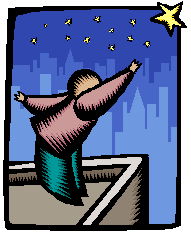How Do Good Teachers View Their Work? (Module 1.5)

According to the National Education
Association (NEA 1997), almost 2/3 of all teachers say that they "certainly" or
"probably would" become a teacher again, if they could start all over. Teacher's
say that their greatest satisfaction comes from knowing that they "made a
difference" in students' lives. What good teachers do can be described in terms
of five modes of teaching (according to Becoming a Teacher, by Forrest W
Parkay and Beverly Hardcastle Stanford, fifth edition).
1. A way of being..
The role of a teacher becomes part of
you. The teacher reads good books and watches good TV.
"They become
living examples for their students, showing that what they say is important
enough for them to apply to their own lives. They are attractive models who
advertise, by their very being, that learning does produce wondrous
results."(Zehm and Kottler 1993, 16)
2. A creative endeavor......
Teaching is a creative endeavor in
which the teacher is continually shaping and reshaping lessons, events and
student experiences. Teachers actually develop "educational relationships" with
their students. For instance, a math teacher may find a way to get each student
to "want" to do well in the class.
"In metaphorical terms, teaching
is....more than carrying brick, mortar, and shovel. Rather, it implies being the
architect of one's classroom world." (The Call to Teach, David Hansen
(1995,13)
3. A live performance....
Teaching is
actually a live performance, and some teacher embrace this performance more so
than others. These kind of teachers believe that through their performance lies
true learning.
"Teaching is full of
surprises;classroom lessons that lead to unexpected questions and
insights;lessons that fail despite elaborate planning;spur-of-the-moment
activities that work beautifully and that may change the direction of a
course;students who grow and learn;students who seem to regress or grow
distant"(Hansen 1995,12).
4. A form of empowerment...
Teachers control many things in a
classroom. They are responsible for what actually happens when students are with
them. Teachers set the pace, evaluating process, and actually determine if a
student passes or fails. That is a lot of power. How a teacher used this power
is critical.
"They (students) can sense how a
teacher feels, especially how she feels about them personally. Students often
find themselves locked into a role that they have played for so long they don't
know how to get out of it. Students deserve the right to have an education. They
should not have to worry about what negative comments their teachers are saying
about them" (Rand and Shelton-Colangelo 1999, 107).
5. An opportunity to
serve.....
Teachers become teachers to serve
others professionally.
From the authors of On Being a
Teacher
Very few people go into education in
the first place to become rich or famous. On some level, every teacher gets a
special thrill out of helping others...(The) teachers who flourish, those who
are loved by their students and revered by their colleagues, are those who feel
tremendous dedication and concern for others-not just because they are paid to
do so, but because it is their nature and their ethical responsibility (Zehm and
Kottler 1993, 8-9)
Remember....The American Dream....

The belief that education can improve the
quality of life....could teachers possibly be the Keepers of the
Dream???
Vocabulary
Modes of Teaching-different
aspects of the teaching function--for example, teaching as a way of being, as a
creative endeavor, as a live performance, and so on.
Activity 1
Choose one of the descriptions above and write a paragraph about the
topic. Include the answers to the following questions.
What do you think that this quote means?
Do you know a teacher that fits this description?
. |
Most of the material in module 1 was
taken from Becoming a Teacher, fifth edition,by Forrest W. Parkay and
Beverly Hardcastle Stanford. |